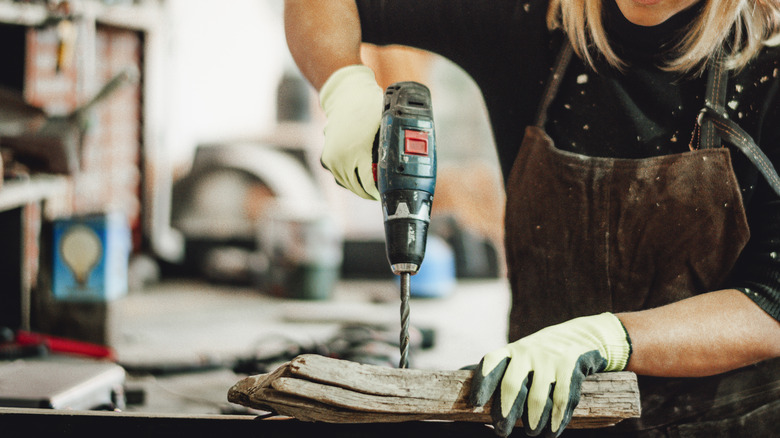How To Clean Your Power Tools The Right Way
While power tools can be useful for cleaning up messes, sometimes they may need a bit of cleaning themselves. General use, and even just time, can lead to various buildup of debris, let alone regular wear and tear.
Strictly speaking, it's not absolutely necessary to clean your power tools regularly — especially larger and more complex devices that require more work to maintain — but failing to do so does have consequences. Poor maintenance leads to a reduced lifespan for the tool, performance degradation, and in some instances, using a tool in such a state could pose a safety risk.
While there are some general steps and suggestions to follow when it comes to cleaning your power tools, it's still recommended that you consult the owner's manual or instructions before attempting to clean or maintain them on your own. Not all devices are built the same, use the same components, or require the same care, and you'll want to make sure to avoid doing anything that might inadvertently cause any damage.
In most cases, you'll want steel wool or a wire brush, toothpicks or Q-tips, household cleaner (double-check that it's safe for tools), a bucket, a cleaning rag, a can of compressed air, smaller tools like a screwdriver or Allen wrench (in case you need to disassemble anything), and some degreaser. It's also a good idea to don PPE gear like gloves and protective goggles before starting.
Cleaning handheld power tools
Once you have all of your cleaning supplies ready, and have put on the necessary protective gear, it's time to get started:
- Turn off the tool and unplug it (corded), or remove the battery (cordless).
- Spray compressed air over moving parts and into vents to loosen up or expel dirt.
- Fill the bucket with a 50-50 mixture of hot water and household cleaner, then use this solution with the wire brush or steel wool to lightly scrub at any visible grime. Be careful not to get any liquid into the vents or electrical components.
- If you've decided to use degreaser, you can also apply some after scrubbing to remove more residue that might remain.
- Use a toothpick or Q-tip to carefully clean inside smaller areas.
- This is also a good opportunity to replace any disposable parts that are in rough shape, such as rubber grips, blades, belts, abrasive surfaces, etc.
- Clean power cords and batteries by wiping them off with a rag dipped in a small amount of your cleaning solution. Make sure batteries are completely dry before using them again.
You can also use some WD-40 (or something similar) after cleaning on metal parts to help protect against future corrosion.
Cleaning large power tools
Larger power tools like stationary equipment can be a bit more labor-intensive to clean, but the process is fairly similar to smaller power tools. Another thing to note is that precision tools may need to be recalibrated once cleaning is finished, depending on the equipment.
- Turn off and unplug the tool.
- Use a vacuum to clean off the exterior.
- Spray compressed air around all of the tool's moving parts and into the vents to blow out excess dirt and dust.
- Wipe off plastic surfaces with a rag dampened with a little water.
- Using a wire brush or some steel wool, gently scrub along metal surfaces to loosen up and remove any visible grime. Degreaser can be used to remove other dirt and residue once you're done scrubbing.
- Spray some corrosion protector (for example, WD-40) over the cleaned metal pieces for added protection. Follow the directions on the spray can for proper application.
- Keeping the tool off and unplugged, inspect all of the moving parts for looseness and unexpected noises (squeaking, rattling, etc.).
- If some components are too stiff, apply lubricant as directed by the lubricant directions or user's manual. If some areas are loose or wobbly, double-check bolts and other connectors and tighten as necessary.
- Replace any disposable parts like blades, saws, sanding surfaces, belts, etc. that are in rough shape.
Once finished, plug the tool back in and give it a quick dry run to make sure everything is clean, running smoothly, and properly tightened.


